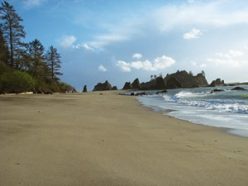Cleaning clothes dirties oceans
Washing polyester fabrics sends plastics to sea

Even people who live far from the beach can pollute coastal areas. All it takes are a washing machine and polyester clothes.
Polyester is everywhere: The plastic fabric is used to make fleeces, shirts, pants, furniture and blankets. It’s synthetic, which means it’s created from chemicals in a lab to resemble something natural. Scientists recently found that in the washing machine, polyester clothes shed plastic fibers. During the rinse cycle, these microscopic threads wash down the drain. From there, they zip through water treatment plants. Eventually, they end up in coastal waters.
This type of plastic pollution is emerging all over the world, says Mark Browne. He’s an environmental scientist at University College Dublin in Ireland. In a recent study, his team collected samples from the shores of six continents. Samples from coasts near to big cities had the most pollution from plastic fibers. Howver, the scientists found the contamination in every habitat they explored.
After finding the plastic threads, Browne and his colleagues went looking for the source. Previous studies had shown that wee bits of plastic show up near where water exits treatment plants. With that in mind, Browne went further back in the water-treatment process. All the way back. Indeed, he took a close look at laundry.
The researchers got to work, repeatedly washed synthetic clothes and blankets in washing machines. After each cycle, they rinsed the clothes thoroughly. Then they filtered the rinse water for plastic threads. “A single garment can produce greater than 1,900 fibres per wash,” they report in a study published September 6. Fleece was the biggest source of the threads.
Polyester fibers aren’t the only tiny polluters. In a November 2010 study, Portuguese researchers found tiny plastic pellets in every sample of sand taken from two beaches. These kinds of small plastic balls give a rough texture to products like skin cleaners and paint removers.
Even though they’re very small, the bits can cause trouble in a watery habitat. “In the ocean, plastics act like a sponge” for many toxic pollutants, Anthony Andrady told Science News. Andrady, who did not work on the new studies, is an expert on polymers at North Carolina State University in Raleigh. Polymers are materials, including plastic, made from long chains of molecules bonded to each other.
These new data on plastic pollution could point to big problems down the road. “I think these findings are a big deal,” says Henry Carson. He’s a marine ecologist at the University of Hawaii at Hilo. Marine ecologists study the sea and how the life forms that live there interact with each other and their environment.
“These tiny pieces have the potential not only to get inside tissues of mussels and other animals,” he told Science News, “but to actually move into their cells. That’s pretty frightening.”
POWER WORDS (adapted from the New Oxford American Dictionary and the American Chemical Society)
polyester A synthetic material used chiefly to make fabrics.
habitat The natural home or environment of an animal.
cell The smallest structural and functional unit of an organism.
ecology A branch of biology that deals with the relations of organisms to one another and to their physical surroundings.
materials science An area of science that studies the relationship between a material’s structure and properties. Chemists who work in the field study how different combinations of molecules and materials result in different properties.







